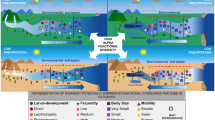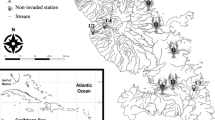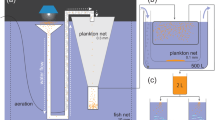Abstract
To analyze density-mediated indirect effects through trophic cascades caused by Japanese dace Tribolodon hakonensis on the algal biomass and growth of ayu Plecoglossus altivelis altivelis, (freshwater fish belonging to Salmoniformes), I introduced zero, five, ten, and 20 dace with and without ayu into experimental pools. Ayu fed predominantly on benthic algae, whereas dace fed on both invertebrates and algae. The percentage of algae in the food content of dace was correlated with the number of dace in a pool. In the experiment lasting 8 days, trophic cascades on algae were not clear. In contrast, when the experimental duration was extended to 20 days, the number of gastropods and ephemeropteran nymphs was negatively correlated with the number of dace, consequently increasing the algal biomass and ayu growth through trophic cascades. Compared with pools with five dace, the presence of ten and 20 dace had similar gross effects on the number of algivorous invertebrates and algal biomass and greater gross effects on the ayu growth. The significant increase in ayu growth in pools with ten and 20 dace strongly suggests that small positive effects on algal growth by dace accumulated and extended to ayu during a 20-day experimental period. These results indicate the importance of analyzing interactions between the density and behavior of the top predator and the experimental duration on the intensity of trophic cascades.




Similar content being viewed by others
References
Abe S, Uchida K, Nagumo T, Ioriya T, Tanaka J (2001) Effects of a grazing fish, Plecoglossus altivelis (Osmeridae), on the taxonomic composition of freshwater benthic algal assemblages. Arch Hydrobiol 150:581–595
Abrams PA (1995) Implications of dynamically variable traits for identifying, classifying and measuring direct and indirect effects in ecological communities. Am Nat 146:112–134
Abrams PA (2004) Trait-initiated indirect effects due to changes in consumption rates in simple food webs. Ecology 85:1029–1038
Berlow EL, Neutel A-M, Cohen JE, de Ruiter PC, Ebenman B, Emmerson M, Fox JW, Jansen VAA, Jones JI, Kokkoris GD, Logofet DO, McKane AJ, Montoya JM, Petchey O (2004) Interaction strengths in food webs: issues and opportunities. J Anim Ecol 73:585–598
Borer ET, Seabloom EW, Shurin JB, Anderson KE, Blanchette CA, Broitman B, Cooper SD, Halpern BS (2005) What determines the strength of a trophic cascade? Ecology 86:528–537
Diehl S (1993) Relative consumer sizes and the strengths of direct and indirect interactions in omnivorous feeding relationships. Oikos 68:151–157
Giller PS, Malmqvist B (1998) The biology of streams and rivers. Oxford University Press, New York
Hill WR, Knight AW (1987) Experimental analysis of the grazing interaction between a mayfly and stream algae. Ecology 68:1955–1965
Hill WR, Boston HL, Steinman AD (1992) Grazers and nutrients simultaneously limit lotic primary productivity. Can J Fish Aquat Sci 49:504–512
Katano O, Aonuma Y (1999) Effects of ayu, Plecoglossus altivelis, on the macroinvertebrate community on cobbles in the Yoda River (in Japanese). Bull Nat Res Inst Fish Sci 14:39–48
Katano O, Aonuma Y (2001) Negative effect of ayu on the growth of omnivorous pale chub in experimental pools. J Fish Biol 58:1371–1382
Katano O, Aonuma Y, Nakamura T, Yamamoto S (2003) Indirect contramensalism through trophic cascades between two omnivorous fishes. Ecology 84:1311–1323
Katano O, Nakamura T, Yamamoto S (2006) Intraguild indirect effects through trophic cascades between stream-dwelling fishes. J Anim Ecol 75:167–175
Kawanabe H (1970) Social behaviour and production of ayu-fish in the river Ukawa between 1955 and 1969, with reference to the stability of its territoriality (in Japanese). Japan J Ecol 20:144–151
Lawlor LR (1979) Direct and indirect effects of n-species competition. Oecologia 43:355–364
Lodge DM, Kershner MW, Aloi JE (1994) Effects of an omnivorous crayfish (Orconectes rusticus) on a freshwater littoral food web. Ecology 75:1265–1281
Miyadi D, Kawanabe H, Mizuno N (1976) Coloured illustrations of the freshwater fishes of Japan (in Japanese). Hoikusha, Osaka
Mizuno N (1991) Gyojoheitanka no eikyo. In: Nakamura N (ed) Sakananiyasashii kawanosugata (in Japanese). Nat Fed Inland Water Fish Cooperatives, Tokyo, pp 81–162
Mizuno N, Kawanabe H, Miyadi D, Mori S, Kodama H, Ohgushi R, Kusakabe A, Huruya Y (1958) Life history of some stream fishes with special reference to four cyprinid species (in Japanese). Contr Lab Physiol Ecol Kyoto Univ 81:1–48
Nakamura M (1969) Cyprinid fishes of Japan (in Japanese). Research Institute for Natural Resources, Tokyo
Nisikawa U, Townsend CR (2002) Functional significance of crayfish in stream webs: roles of omnivory, substrate heterogeneity and sex. Oikos 98:512–522
Polis GA, Strong DR (1996) Food web complexity and community dynamics. Am Nat 147:813–846
Polis GA, Sears ALW, Huxel GR, Strong DR, Maron J (2000) When is a trophic cascade a trophic cascade? Trends Ecol Evol 15:473–475
Power ME (1992) Top-down and bottom-up forces in food webs: Do plants have primacy? Ecology 73:733–746
Pringle CM, Hamazaki T (1998) The role of omnivory in a neotropical stream: separating diurnal and nocturnal effects. Ecology 79:269–280
Rosemond AD, Mulholland PJ, Elwood JW (1993) Top–down and bottom–up control of stream periphyton: effects of nutrients and herbivores. Ecology 74:1264–1280
SAS Institute (1998) Stat view for Macintosh and Windows. Version 5.0. SAS Institute Cary, North Carolina
Schmitz OJ, Hamback PA, Beckerman AP (2000) Trophic cascades in terrestrial systems: a review of the effects of carnivore removals on plants. Am Nat 155:141–153
Schmitz OJ, Krivan V, Ovadia O (2004) Trophic cascades: the primacy of trait-mediated indirect interactions. Ecol Lett 7:153–163
Steinman AD, Lamberti GA (1996) Biomass and pigments of benthic algae. In: Hauer FR, Lamberti GA (eds) Methods in stream ecology. Academic, San Diego, pp 295–313
Tsuda M (1962) Ecology of aquatic insects. In: Tsuda M (ed) Aquatic entomology (in Japanese). Hokuryukan, Tokyo, pp 227–251
Werner EE, Peacor SD (2003) A review of trait-mediated indirect interactions in ecological communities. Ecology 84:1083–1100
Wootton JT (1994) The nature and consequences of indirect effects in ecological communities. Ann Rev Ecol Syst 25:443–466
Acknowledgments
We thank C. Norman for his critical review of the manuscript, and F. Onuma, A. Ishihara, and A. Seki for help and discussion. This study was supported by a grant-in-aid from the Ministry of Agriculture, Forestry and Fisheries, Japan. This paper is a contribution (No. B-464) from the National Research Institute of Fisheries Science, Japan. The experiments conducted in this study comply the current laws of Japan.
Author information
Authors and Affiliations
Corresponding author
Additional information
Communicated by Matthias Schaefer.
Rights and permissions
About this article
Cite this article
Katano, O. Effects of experimental duration and density of Japanese dace Tribolodon hakonensis on the strength of trophic cascades on benthic algae. Oecologia 154, 195–205 (2007). https://doi.org/10.1007/s00442-007-0827-7
Received:
Accepted:
Published:
Issue Date:
DOI: https://doi.org/10.1007/s00442-007-0827-7




